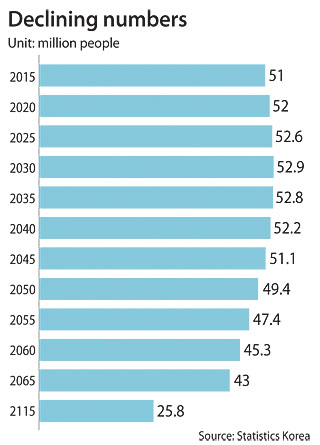Shrinking of Korea’s population accelerates

Statistics Korea’s projection of the country’s fertility rate worsened compared to the same outlook made five years ago as young people who have little interest in marriage and having children continue to grow.
According to the government statistics office Thursday, the lifetime fertility rate (the number of births per woman during her lifetime) in 2035 is expected to be 1.35 per woman, down from 1.42 projected in 2011. The outlook for 2050 was lowered from 1.42 to 1.38.
The statistics agency revises its population prediction every five years.
“Fewer Koreans are getting married and the average age of women when they get married continues to rise compared to the past,” said Lee Jee-yeon, a director at Statistics Korea. “Major economic indications, including the labor market, remain weak and a greater number of Koreans are postponing marriage or simply don’t get married because of that. Housing prices, including that of jeonse [long-term rent deposits], also have soared when compared to the past, and this puts a greater financial burden on young Koreans.”
The downsizing of Korea’s population has long been considered one of the greatest risks to sustainable growth. Korea’s economic growth is expected to stagnate or go into steady decline like other advanced economies such as Japan.
The statistics agency said it lowered the projections because the birth rate in recent years was lower than in its 2011 outlook.
According to the data, the average age of Korean woman marrying for the first time rose 0.2 years year on year to 30 in 2015, the first time it crossed the 30 threshold. The number of marriages reported to the government dropped from 305,500 in 2014 to 302,800 last year, which was the lowest figure since 2003.
Statistics Korea said the population is likely to start declining from 2031 and total population will slide into 1990s levels after 2065.
Korea’s population will peak at 52.96 million in 2031 and slump to as low as 43 million in 2065.
“The population will fall to half of what it is right now in 100 years if the current trends remain unchanged,” said Lee. She noted that the population will be around 25.8 million in 2115.
The number of babies born will decrease from 430,000 a year in 2015 to 260,000 in 2065, while the number of people dying every year will rise from 280,000 to 740,000 in the same period, Statistics Korea said.
The statistics agency also described the rapid aging of Korean society from now on. Koreans aged over 65 accounted for 12.8 percent of the total population in 2015, which is expected to reach 28.7 percent in 2035 and 42.5 percent in 2065.
“A 12.8 percent level is relatively low when compared to other Organization for Economic Cooperation and Development (OECD) member states, but 42.5 percent in 2065 will be one of the highest among them,” said Lee.
The number of people aged 85 and over will rise from 510,000 in 2015 to 5.05 million in 2065. They now only account for 1 percent of the population but it will rise to 11.7 percent in 2065.
As society ages, the working age population, or those between 15 and 64, will fall after hitting a peak this year. The number of such people will drop 340,000 every year starting from 2020 and the figure will fall by 440,000 a year starting from 2035.
If the current trends continue, 100 working age people will have to take care of 108.7 seniors by 2065, which is sharp increase from 36.2 recorded in 2015. Korea ranked the lowest in the OECD for such a figure in 2015, but will become the no. 1 country in 2065. The 108.7 figure will be even higher than Japan’s 97.
Due to the low birth rate, Koreans aged 14 and younger will drop as well. They now account for 13.8 percent of the total population but are expected to drop to 9.6 percent in 2065.
Men’s life expectancy is expected to rise from 79 in 2015 to 88.4 in 2065 and the figure for women is projected to go up from 85.2 to 91.6.
BY KIM YOUNG-NAM [kim.youngnam@joongang.co.kr]










with the Korea JoongAng Daily
To write comments, please log in to one of the accounts.
Standards Board Policy (0/250자)